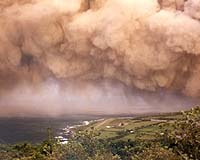
|
| ©Unknown |
| Volcanic ash cloud. |
The Arctic system is the most sensitive climate zone on Earth and can have pronounced and wide-ranging effects on the Earth's climate. Snow and ice cover much of the Arctic's land and sea, creating a white sheet that reflects the sun's rays back into the atmosphere and results in an overall cooling effect. A seasonal change in this reflectivity is normal, but problems can arise when global temperatures rise or fall slightly.
For example, in particularly cold years, prolonged expansion of large areas of snow and sea ice during the summer can decrease the area of exposed land and sea, causing decreased solar absorption that leads to further atmospheric cooling. Even small changes in temperature can result in these positive feedback loops that rapidly compound into significant worldwide effects.
"If areas of open water are replaced with snow and ice, it dramatically changes the whole system's reflectivity," said Bradley. "Any time you disturb the atmosphere, it responds in a certain way and you get circulation changes. The Arctic is sensitive to small climate fluctuations, and it affects other parts of the globe."
Bradley's current research focuses on another source of fluctuations in Arctic reflectivity: volcanoes. Most volcanic eruptions result in hot magma that flows down the side of the volcano. But some eruptions are explosive, Bradley said, sending tiny bits of ash, called tephra, into the atmosphere. Only a little bigger than grains of pollen, these bits get caught in the stratosphere and disperse, sometimes for years, before settling to the ground all over the Earth. But while they're caught in the atmosphere, they can act similarly to Arctic ice and reflect the sun's rays.
"It's hard to see it with the naked eye, but in large amounts it can increase reflectivity in the stratosphere," said Bradley.
Bradley will use ice cores and sediment cores from lakes and the ocean to find trace bits of tephra from the past 12,000 years. Using radiocarbon dating and other techniques, the researchers can discern how old the tephra is. They then combine these data with models of historical climate change to determine what role volcanic events have played in Earth's major climate shifts.
In the late 1990s, Bradley was part of a research initiative that found that the last few decades of the 20th century were warmer than any comparable period in the last 400 years, a finding that was later confirmed by the National Academy of Sciences. Knowing all the factors that influence our climate can ensure that researchers don't underestimate human impacts on global warming, Bradley said.
"What we're trying to understand are the mechanisms by which the Arctic system operates," Bradley said. "We want to know how sensitive our climate system is to things other than greenhouse gases."
The Climate System Research Center is a facility focused on the climate system, climatic variability and global change issues. The center uses both modern and historic climate data to model and predict changes to the Earth's climate.



They know their "human caused global warming" rant is nonsense and they really do want to know what is going on.